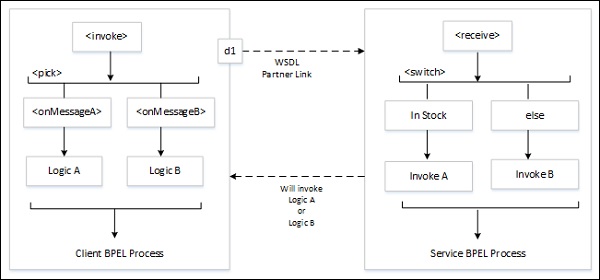
- BPEL - Home
- BPEL - Introduction
- BPEL - Activities
- Partner Link in BPEL Process
- Creating a Partner Link
- BPEL - Adapters
- Process Monitors
- One-Way Messages
- Synchronous Interactions
- Asynchronous Interactions
- Asynchronous Interactions with a Timeout
- Asynchronous Interactions with a Notification Timer
- One Request, Multiple Responses
- One Request, One of Two Possible Responses
- One Request, a Mandatory Response, & an Optional Response
- Partial Processing
- Multiple Application Interactions
- Invoking a Synchronous Web Service
- Invoking an Asynchronous Web Service
- Using Parallel Flow
- Using Conditional Branching
- Using Fault Handling
- Resubmitting a Faulted Process
- Incorporating Java & Java EE Code
- Manipulating XML Data
- Using Correlation Sets & Message Aggregation
- Using Events & Timeouts in BPEL Processes
- Using the Notification Service
- Using Oracle BPEL Process Manager Sensors
- Difference between BPEL 1.1 & BPEL 2.0
One Request, One of Two Possible Responses
In this chapter, we will learn about the concept of one request and one of two possible responses.
-
The Client BPEL Process sends a single request to the Service BPEL Process and receives one of two possible responses.
For example, the request can be to order a product online, and the first response can be either an in-stock message, or an out-of-stock message.
The Client BPEL Process needs the following −
An invoke activity to send the request.
A pick activity with two branches: one onMessage for the in-stock response and instructions on what to do if an in-stock message is received.
A second onMessage for the out-of-stock response and instructions on what to do if an out-of-stock message is received.
The Service BPEL Process needs a receive activity to accept the message from the client, and a switch activity with two branches, one with an invoke activity sending the in-stock message if the item is available, and a second branch with an invoke activity sending the out-of-stock message if the item is not available.
As with all partner activities, the Web Services Description Language (WSDL) file defines the interaction.
